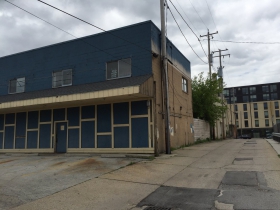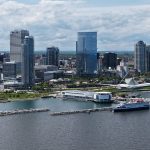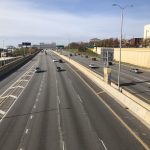Catalytic Development for North Avenue?
Robert Schmidt sells two East Side properties. And a really old grocery store will become high-end apartments.
Tom Daykin of the Milwaukee Journal Sentinel reported this week that Robert Schmidt Jr., owner and operator of several bar and restaurants in the city and region, sold two of his properties. One of which could become a new catalytic development for North Avenue.
Schmidt recently sold RC’s Beer Garden at 1530 E. North Ave., and the building at 2850-2862 N. Oakland Ave. that was home to Black Rose Irish Pub and Monster Pizza. The latter closed a year ago.
Chris Karampelas the owner of Oakland Gyros, a popular restaurant across the street from the former Black Rose, bought the building for $1.15 million, Daykin reported. He has plans to remodel the apartments on the second floor and will seek new commercial tenants for the street level.
The 11,640 square-foot loot is currently zoned LB3. A city powerpoint explaining the zoning designation notes this designation can be applied to potentially catalytic sites. This parcel is directly adjacent and across the street from two relatively large commercial and industrial buildings, both vacant.
This zoning designation is relatively new to the city. It allows for higher density development, “Promoting compact pedestrian friendly districts,” and buildings up to 75 feet tall, but no shorter than 30 feet. The current RC’s building is more in line with what the previous zoning likely was, LB2, which allowed for smaller buildings with a larger parking lots.
Daykin reported that John Kesselman, Walia’s broker on the deal, said the possibilities are “Up in the air,” as to what will happen next at the site. But based on the new zoning designation, and its location near a commercial strip and university housing, I’d say it’s ripe for a brand new development. And with the vacancies in the immediate area, a smart development could spur change through the entire block.
1530 E. North Ave.
Some Bucks News, Old and New
How many times does Jeramey Jannene have to tell you people, the new Bucks arena will not be named for Fiserv?
Jannene published another piece saying as much this week after Sports Business Daily floated the rumor. He’s said it once, he’s said it twice, please don’t make him say it thrice.
In other Bucks news, Good City Brewing, which is just over two years old, will open an 11,000 square foot brewery in the live block. The brewery will still operate their Farwell location. But the new space will allow them to brew some sour and small batch beers, Jannene reported, along with being an great new location for the company.
Old Grocery to become high end apartments
In April of 2017, Michael Horne reported that an old Grocery in the Brady Street neighborhood had been sold. And this week, Tom Daykin reported that the site at 1816-1822 N. Humboldt Ave. will be redeveloped into eight “high end apartments.”
Read Tom Daykin here for the some details on the future apartments. And read Michael Horne here for a dive into the buildings history.
In Other News:
- The Sherman Phoenix picked up half a million from a foundation, only another half million to go, reports Corri Hess at BizTimes.
- Also from Hess, condo sales downtown are up seven percent.
- And Jannene has photos of The Contour on Farwell Avenue.
If you think stories like this are important, become a member of Urban Milwaukee and help support real, independent journalism. Plus you get some cool added benefits.
Plats and Parcels
-
New Third Ward Tower Will Be Milwaukee’s Priciest
 Mar 3rd, 2024 by Jeramey Jannene
Mar 3rd, 2024 by Jeramey Jannene
-
New Corporate Headquarters, 130 Jobs For Downtown
 Feb 25th, 2024 by Jeramey Jannene
Feb 25th, 2024 by Jeramey Jannene
-
A Four-Way Preservation Fight Over Wisconsin Avenue
 Feb 18th, 2024 by Jeramey Jannene
Feb 18th, 2024 by Jeramey Jannene





























“Catalytic development” gets thrown around way too much on projects east of 43. The real opportunity for “catalytic development” is in the N. 27th & N. 35th street corridors, where we’ve undermined the important commercial districts through post-WW2 road widening schemes. Today, there’s a crisis of “bad urbanism” that we fail to address in several neighborhoods. We have too many neighborhood streets with highway design speeds. We have absurd pork chop mini on-ramps that have wiped out the corner commercial lots – destroyed local amenities & community-owned businesses.
The city needs to take out a map, pick a couple nodes worth salvaging into a coherent commercial districts, and give them the “S. 5th street-treatment.” I.e. neck the streets down to 1 lane in each direction, widen sidewalks, add some decent street lighting, plant some street trees, install few benches, mark cross walks & parking lanes, and provide ample controlled intersections. There’s no reason why 35th street shouldn’t look like Oakland through Shorewood. The difference is we’ve decided 35th should act like a freeway & repel commercial activity, while shorewood wants their commercial district to succeed and thus provides for safe on-street parking & walkability.
35th
https://www.google.com/maps/@43.0597515,-87.9574816,3a,75y,10.11h,87.09t/data=!3m6!1e1!3m4!1sFk_s2iAbQ15yE1SM6vWc1Q!2e0!7i13312!8i6656
Oakland
https://www.google.com/maps/@43.0898085,-87.8874585,3a,75y,1.34h,79.62t/data=!3m6!1e1!3m4!1sNTYlT0yUsz8kBrH3cdQ2tQ!2e0!7i13312!8i6656
@Michael…. I completely agree! We DO not focus enough on the corridor, Roads are too wide and cars drive way too fast. A great example is along east Center, between Holton and Humboldt… its a freeway. It could be so much more.
Don’t narrow anymore roads in Milwaukee. Enforce the speed limits. None of this “warning” from the Police unless it is 10 or 15 miles over the speed limits before they issue to avoid losing in court.
Road design determines how fast people drive,
@dag999, narrowing the road reduces the life cycle cost of the road. While increasing enforcement, increases police cost. As a tax payer, i generally support things that save money while creating positive outcomes.
@Mike & David. What a silly answer/solution this is for slowing traffic and making our streets last longer!!!! Why not just close the road to cars then? It would save even more money, and increase the roads life cycle even more, wouldn’t you agree? In fact, I just read somewhere that a traffic light costs $250,000 at an intersection. So let’s design to eliminate those as well. And since many have said turnarounds save money, why not design one at each major intersection on all streets, including Downtown! Less electricity too, and no maintenance if traffic signals go on the fritz, or there is a power outage and you need traffic cops to direct it. That would reduce more of hose costs you allude to.
Narrowing streets means that the first time someone double parks or has an accident, traffic is obstructed. Grand mama parallel parking slows traffic, so let’s design no parking along those streets too. In congested business areas, one delivery truck, whether it be UPS or a food service company dropping off supplies to a restaurant, stops traffic. So let’s design them to eliminate truck deliveries to businesses. Even a bus going down the street will slow traffic to a crawl on a single lane road, even if there are designated drop off areas. You worry about increased costs of law enforcement, so why not suggest we eliminate that too? After all, even a Police Officer doing a traffic stop, or chasing the ever increasing amount of stolen cars crashing in our wonderful city, costs time and labor, and lord only knows how that closes streets when it crashes on a narrow street. And no car at all means an area that is totally pedestrian friendly — and we are all for that, aren’t we? Let’s just close those streets and reduce even more costs and save more money.
There are many other ways that we can save reduce costs and save tax dollars, but that seems to fall on deaf ears. Narrowing streets and intentionally slowing traffic will just force cars onto other roads as they try to avoid the hassle and congestion that this new “design” will bring. I can’t wait to see what happens in Shorewood when they narrow Lake Drive under these new “design” guidelines.
DAG999,
How often, on a given street, is traffic obstructed by an accident, parallel parking, police/fire activity, or a stopped bus? I suspect it’s less than 1% of the time, and you shouldn’t double your costs to fix a minor problem (usually wasting just a few seconds) that doesn’t even exist 99% of the time.
Double-wide streets double costs (not just for paving, but also for snow removal, street cleaning, and sewer treatment). Much more important, double-wide streets more than double pedestrian deaths—because wider, unobstructed lanes encourage faster driving.
When hit by a car, a pedestrian’s survival chances depend on the speed of the vehicle, and between 20 and 40 mph, pedestrian fatalities nearly double for each 10 mph increase in speed.
http://humantransport.org/sidewalks/SpeedKills.htm
p.s. Double-parking is a separate issue, an anti-social behavior which is actually encouraged by having double-wide streets (“Why waste time pulling up to the curb when there are so many lanes here?”)
You’re being a little absurd DAG999….